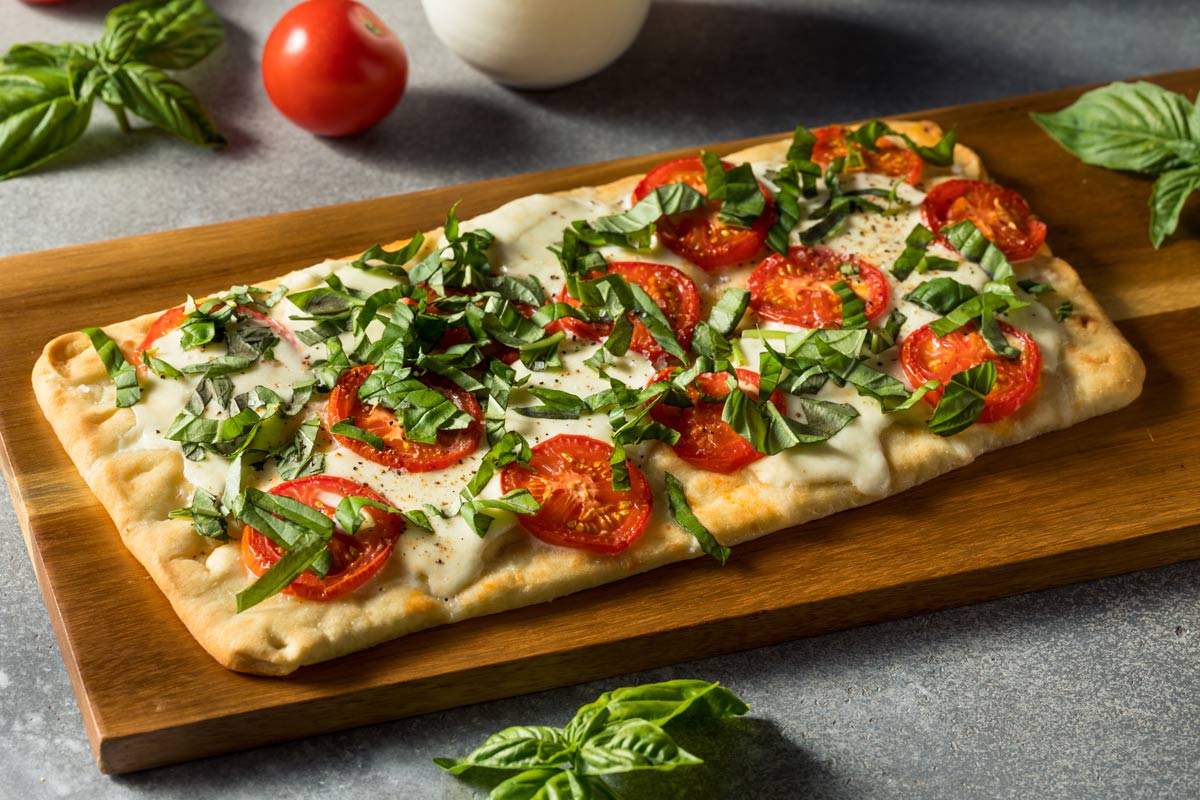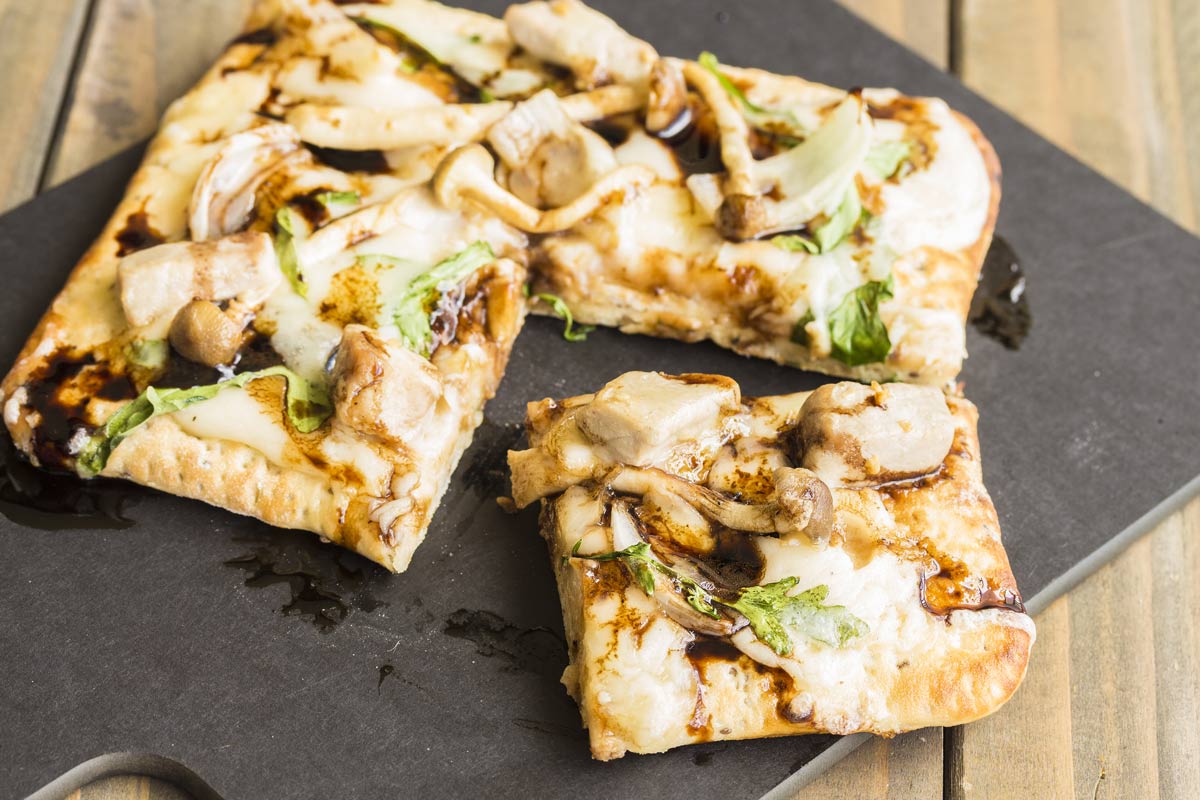Flatbreads Recipe with Quick Tips and Loads of Toppings, For Your Best Health: The Mediterranean Lifestyle Goes Global
Some of the times I treasure most on my travels for the Fresh-Pressed Olive Oil Club are festive meals around a large table filled with friends. Yes, the food is magnificent because it’s most often locally sourced and prepared with love, whether at an olive grower’s farm or a neighborhood ristorante, but there’s more. It’s the convivial atmosphere that sticks with me as much as the first taste of a harvest’s olive oil—sharing time with people who have become my friends over the years.
Just how important all these components are to the health benefits of the Mediterranean diet is evident in a new study I’m sharing with you here. What makes this research different from many others on the health benefits of olive oil and following this diet is that its participants live in the UK, not one of the countries around the Mediterranean Sea. It shows that you can “export” this way of life and enjoy a longer life! Just how versatile is the Mediterranean diet? You can customize the following recipe in dozens if not hundreds of ways—and I’m starting you off with 10 delicious combinations!
Flatbreads Your Way
 Flatbreads Your Way
Flatbreads Your WayWhat makes a flatbread different than a pizza? Traditional flatbread dough doesn’t require yeast, so the prep time is faster than that of the yeasted dough for pizza. My approach takes the best of both worlds by using freshly prepared pizza dough, available at most supermarkets, and shaping it into two thin rectangles—flatbreads are often just a 1/4-inch thick. After a 5-minute pre-bake, it’s up to you to customize the toppings to your liking.
Ingredients
- 1 pound store-bought pizza dough, white or whole wheat, at room temperature (multiply as needed for additional servings)
- Extra virgin olive oil
- Sea salt
- Your choice of toppings…
Ingredients
- Classic Margherita—crushed tomatoes, sea salt, basil, and mozzarella slices
- New Caprese—pesto, burrata slices, cherry tomato halves, and balsamic vinegar; finish with basil after baking
- White—ricotta, mozzarella, and fontina; finish with shavings of Parmigiano-Reggiano after baking
- Tomato sauce, sautéed sausage chunks, steamed broccoli florets, and smoked mozzarella slices
- Mushrooms, caramelized onions, and shredded fontina
- Aioli, sliced steak, gorgonzola, and pine nuts; finish with balsamic vinegar after baking
- Prosciutto, slices of goat cheese and figs, roasted squash or beet cubes, and hazelnuts
- Skyr or sour cream, smoked fish, capers, and red onion rings; finish with fresh dill after baking
- Tiny clams (canned), garlic, freshly grated Parmigiano-Reggiano, and crushed red pepper flakes
- Salami or pepperoni slices, cherry tomato halves, quartered artichoke hearts, and dried oregano
Directions
Step 1
Note: The dough can be fully baked for 10-15 minutes, if you want to top it with ingredients that don’t need cooking, or pre-baked, as described below, to get it crusty before you layer on fixings such as cheese to be melted. After baking, sprinkle on delicate ingredients that would quickly burn to a crisp in a 450°F or higher oven, such as arugula, cheese shavings, or a drizzle of balsamic vinegar along with more olive oil.
Step 2
Heat your oven (not the broiler) to its highest setting, usually between 450°F and 500°F. Prepare a rimmed sheet pan by coating it with 1-2 tablespoons of olive oil.
Step 3
Cut your dough in half and shape into rectangles with your fingers or a rolling pin. Use your knuckles to make a dimple pattern across the dough and gently brush the surface with more oil; sprinkle lightly with the salt.
Step 4
Bake for about 5-8 minutes or until firm and light brown. Remove from the oven and top as desired. If using one of the above combinations, add everything except any finishing ingredient, in the order given.
Step 5
Return to the oven for 5-10 minutes or until the cheese has fully melted. Top with any finishes and another drizzle of olive oil, and serve.
Yields 2 servings

For Your Best Health
The Mediterranean Lifestyle Goes Global
The Study: “Association of a Mediterranean Lifestyle With All-Cause and Cause-Specific Mortality: A Prospective Study from the UK Biobank,” Mayo Clinic Proceedings, 2023.
The objective: To examine the association between the Mediterranean lifestyle and all-cause, cancer, and cardiovascular disease (CVD) mortality in a British population.
How the study was done: The researchers from La Universidad Autónoma de Madrid and Harvard T.H. Chan School of Public Health analyzed the habits of 110,799 members of the UK Biobank Cohort, a population-based study across England, Wales, and Scotland, using the Mediterranean Lifestyle (MEDLIFE) index, which is derived from a lifestyle questionnaire and diet assessments.
Participants, who were between the ages of 40 and 75, provided information about their lifestyle according to the three categories the index measures: “Mediterranean food consumption” (intake of foods part of the Mediterranean diet such as fruits and whole grains); “Mediterranean dietary habits” (adherence to habits and practices around meals, including limiting salt and drinking healthy beverages); and “physical activity, rest, and social habits and conviviality” (adherence to lifestyle habits including taking regular naps, exercising, and spending time with friends). Each item within the three categories was then scored, with higher total scores indicating higher adherence to the Mediterranean lifestyle.
What the study found: The researchers followed up nine years later to examine participants’ health outcomes. Among the study population, 4,247 died from all causes, 2,401 died from cancer, and 731 died from cardiovascular disease. Analyzing these results alongside MEDLIFE scores, the researchers observed an inverse association between adherence to the Mediterranean lifestyle and risk of mortality. Participants with higher MEDLIFE scores were found to have a 29% lower risk of all-cause mortality and a 28% lower risk of cancer mortality compared to those with lower MEDLIFE scores. Adherence to each MEDLIFE category independently was associated with lower all-cause and cancer mortality risk. The “physical activity, rest, and social habits and conviviality” category was most strongly associated with these lowered risks, and additionally was associated with a lower risk of cardiovascular disease mortality.
The key takeaway: While many studies have established the health benefits of a Mediterranean diet and lifestyle, little research has been done on followers of the diet outside of its region of origin. “This study suggests that it’s possible for non-Mediterranean populations to adopt the Mediterranean diet using locally available products and to adopt the overall Mediterranean lifestyle within their own cultural contexts,” says lead author Mercedes Sotos Prieto, Ramon y Cajal research fellow at La Universidad Autónoma de Madrid and adjunct assistant professor of environmental health at Harvard Chan School. “We’re seeing the transferability of the lifestyle and its positive effects on health.”
Get More Recipes In Your Inbox!
